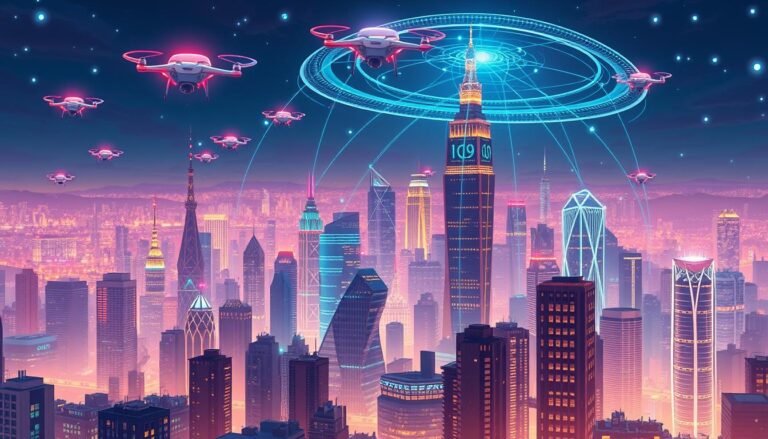Edge Computing Trends: Decentralizing Data Processing in 2025
Imagine if we could solve our cloud problems by moving data processing closer to its source. By 2025, edge computing could change how we handle IT, moving data processing to the edge of networks. This shift is becoming more popular as a way to fix cloud computing’s issues like slow speeds, security problems, and unreliable connections.
Edge computing is ready to tackle the 75% of data created outside big data centers. Companies like VMware are leading the way, using new tech to make this change affordable and effective. The edge computing market is expected to grow to $378 billion by 2028, thanks to the need for quicker, more reliable data processing for real-time analytics and AI.
Key Takeaways
- Edge computing can reduce latency by up to 90%, significantly improving real-time processing capabilities.
- By 2025, 75% of all data will be generated outside traditional data centers and cloud environments.
- Global edge computing market projected to hit $15.7 billion by 2025, growing at a CAGR of 34.9%.
- Integration of edge computing and IoT expected to create up to $1.5 trillion in economic value by 2025.
- Hyperscalers like VMware are enhancing edge computing with advanced hyperconverged infrastructure solutions.
- Edge computing adoption anticipated to be integral for over 40% of larger enterprises by 2025.
Introduction to Edge Computing
Edge computing changes how we process data by moving it closer to where it’s created. This cuts down on delays and makes better use of bandwidth. It’s expected to be worth $15.7 billion by 2025, thanks to more IoT devices and the need for quick data handling.
What is Edge Computing?
Edge computing puts storage and servers near data sources. This cuts down on the need to send lots of data to big data centers. It makes data analysis faster, lowers delays, and boosts app performance.
It also helps keep data safe by handling it locally. This reduces the chance of data breaches and cyber attacks.
History and Evolution of Edge Computing
Edge computing started in the early 2000s, as cloud computing’s limits became clear. Clouds were good for some tasks but not for quick data needs. Now, only 27% have used edge computing, but 54% find it appealing.
Role of Distributed Computing Architecture
Distributed computing is key to edge computing. It uses many nodes to process data near its source. This makes systems more reliable and scalable, vital for many industries.
By 2025, 75% of data will be outside big data centers. This shows how crucial edge and distributed computing are.
Edge computing is vital for fast data handling, like in self-driving cars. It cuts down on delays, saving on network costs and improving security. For example, MEC brings resources closer to users for better performance.
Integration with Internet of Things (IoT)
The Internet of Things (IoT) is growing fast, making edge computing more important. As more devices connect, managing data becomes key. Edge computing handles data close to the source, making apps faster and decisions quicker.
IoT Devices and Data Generation
IoT devices are at the heart of edge computing. They collect and send data in real-time. This local processing cuts down on the need for distant data transfer, saving bandwidth and time.
Edge computing makes IoT apps more responsive. This boosts efficiency in Smart Cities.
Benefits of Edge Computing in IoT
Edge computing with IoT brings many advantages:
- Reduced Latency: It cuts down on delays by processing data locally.
- Enhanced Security: It keeps data safe by processing it close to the source.
- Operational Efficiency: It helps industries like manufacturing and healthcare run better.
- Bandwidth Optimization: It saves bandwidth by processing data locally.
Case Studies and Applications
Edge computing with IoT is changing many fields:
- Manufacturing: It makes maintenance predictions, cutting downtime and improving schedules.
- Healthcare: It allows for remote patient care, speeding up help.
- Retail: It improves inventory and pricing, making shopping better.
- Transportation: It optimizes routes and checks vehicle health, saving time and fuel.
Edge computing is making IoT systems better and more valuable. By 2025, it’s expected to be worth $1.5 trillion. This shows its big role in IoT and Smart Cities.
Technological Advancements Driving Edge Computing
Recent tech advancements are changing how we use edge computing. The rollout of 5G networks brings faster speeds and lower delays, helping edge computing a lot. Also, Artificial Intelligence (AI) and Machine Learning (ML) are making data handling faster and more accurate. Plus, Hyperconverged Infrastructure (HCI) is key, offering affordable and scalable options. These advances are pushing the edge computing market forward, making operations better in many fields.
Role of 5G Networks
The arrival of 5G networks will greatly change edge computing’s future. 5G makes edge apps stronger and quicker, mixing edge and cloud computing. This means faster data handling and self-running systems. Healthcare, manufacturing, and smart cities will see big benefits from this better connection.
Impact of Artificial Intelligence (AI) and Machine Learning (ML)
AI and ML are becoming more common in edge computing. They help with quick data analysis, predictive upkeep, and smart choices in many areas. For example, AI and ML at the edge help with industrial automation, smart cities, and tailored healthcare. This boosts efficiency and brings new ideas.
Innovations in Hyperconverged Infrastructure (HCI)
Hyperconverged Infrastructure is changing how we build and manage edge computing setups. It combines storage, computing, and networking into one, making things more affordable and scalable. This is great for cutting costs and using resources better. As edge computing needs grow, HCI’s new ideas will be key for keeping data processing fast at the edge.
Edge Computing Trends: Decentralizing Data Processing
Edge computing trends are moving towards decentralized data processing. This change is key for industries wanting to improve data flow and reduce delays. It helps in making quicker decisions in real-time.
Decentralized Data Processing
Decentralized data processing is changing how we manage data. Traditional methods can’t handle today’s data needs. Edge computing solves this by placing data processing closer to where data is created.
This approach cuts down on delays and boosts data safety. Retail, healthcare, and industries use it to lower costs and improve efficiency.
Edge Analytics and Real-Time Data Processing
Edge analytics is vital for real-time data processing. It’s needed for things like self-driving cars and remote health monitoring. Edge devices can offer quick insights and actions, reducing delays by 75%.
This method also saves network bandwidth by up to 50%. It reduces the need to send large data sets to central servers.
Future of Distributed Cloud Computing
The future of cloud computing is looking at distributed models. This combines public, private, and hybrid clouds. It offers more control and faster speeds, with hybrid edge-clouds expected to grow by 40% by 2025.
Edge computing’s infrastructure is set to grow by 65%. It’s known for its flexibility and energy efficiency. Edge intelligence is also expected to jump by 90%, making local processing and analytics more important for a connected world.
| Metric | Percent | Details |
|---|---|---|
| Latency Reduction | 75% | Faster response for critical applications |
| Hybrid Edge-Cloud Adoption | 40% | Combining strengths of edge and cloud computing |
| Scalable Infrastructure Demand | 65% | Flexibility in managing edge devices |
| Edge Intelligence Implementation | 90% | Local processing and analytics tasks |
| Data Governance Complexity | 30% | Challenges in security and compliance |
| Edge-Native Processing Adoption | 45% | Leveraging edge-generated data |
| Network Bandwidth Optimization | 50% | Minimized need for data transmission |
The future of decentralized data processing looks bright. New technologies like blockchain will ensure data safety across nodes. The coming 5G will also make distributed cloud systems faster and more efficient.
Industry Impacts and Economic Benefits
The rise in edge computing is changing many industries, bringing big economic benefits. The market is growing fast, from $3.5 billion in 2020 to over $15 billion by 2025. This growth is seen in many areas, like manufacturing and healthcare, where quick data processing is key.
Market Growth Projections
Edge computing is growing fast because it brings data processing closer to where it’s needed. This cuts down on delays, saves bandwidth, and boosts security. The market is expected to grow as more people want solutions that process data quickly and securely.
Sector-Specific Use Cases
Edge computing is useful in many areas, making things more efficient and innovative. In healthcare, it helps with remote monitoring, allowing for quick analysis of patient data. In manufacturing, it boosts productivity and makes operations smoother.
Smart cities use edge computing for better traffic flow, energy use, and safety. Retailers use it to offer better customer service and manage inventory more effectively.
Impact on Small and Medium-Sized Businesses (SMBs)
For SMBs, edge computing is a game-changer. It helps them stay competitive by quickly processing data and making smart decisions. Edge solutions are affordable, making top-notch technology available to more businesses. This helps SMBs grow without spending too much.
Edge computing also cuts down on costs and improves data security. It keeps important information safe by keeping it closer to the source.
Here’s a table showing the benefits of edge computing in different industries:
| Industry | Edge Computing Benefits |
|---|---|
| Healthcare | Remote medical monitoring, real-time data processing |
| Manufacturing | Improved productivity, Industry 4.0 implementation |
| Smart Cities | Traffic management, energy optimization, public safety enhancement |
| Retail | Personalized services, inventory management |
| Education | Enhanced e-learning platforms, real-time analytics |
Conclusion
Edge computing is changing how we process and use data in many areas. It moves data processing closer to where it’s needed, making data analysis faster and more accurate. This is key for industries that need quick, smart decisions.
More money is being put into edge computing, showing people believe in its power. It’s becoming crucial for real-time data analysis and making decisions on its own. This is especially true in the Industrial Internet of Things (IIoT).
Adding AI and machine learning makes edge computing even better. It leads to smarter, more efficient work in healthcare, manufacturing, retail, and transportation. This technology is pushing what’s possible in these fields.
Future trends show edge computing will work with AI, robotics, and autonomous systems. It will change industries with digital twin technology and save energy. Even with challenges like keeping data safe, solutions like cloud management and 5G are helping.
In short, investing in edge computing is opening up new opportunities for growth. It’s helping us meet the needs of a data-driven world. It gives us quick, valuable insights that help us grow and stay sustainable.
Source Links
- Edge Computing: Decentralizing Data Processing
- Edge Computing – Revolutionizing Data Processing in IoT
- Council Post: 2025 IT Infrastructure Trends: The Edge Computing, HCI And AI Boom
- What Is Edge Computing? Everything You Need to Know
- Edge computing is transforming the way we process data
- Edge Computing: Revolutionizing Data Processing
- Edge Computing: Revolutionizing Real-Time Applications with Decentralized Processing
- Edge Computing IoT: Definition, Benefits, and Key Trends
- 5 Internet of Things (IoT) Edge Computing Trends | Datamation
- Edge Computing Futureproofing: Evolution of Distributed Data Processing
- The Rise of Edge Computing: Transforming Data Processing and Analytics
- Edge Computing: Empowering Decentralized Data Processing
- Edge Computing in Data Management – DataScienceCentral.com
- Understanding Edge Computing in a Decentralized World
- The Rise of Decentralised Computing: How Smart Edge Transform Industries – Calsoft Blog
- Edge Computing: Future of Tech, Business, & Society
- Edge Computing: Revolutionizing Data Processing
- Edge Computing in IIoT: Enhancing Real-Time Data Processing
- Edge Computing: Revolutionizing Data Processing in the Digital Age
- Edge Computing: Redefining Data Processing for Faster Results – Absolin








